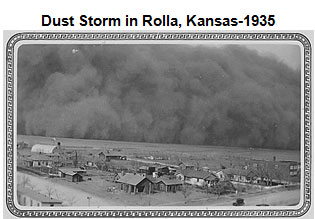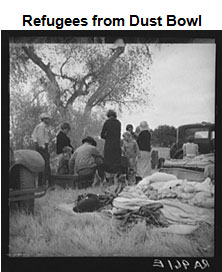
Source: Massive Dark cloud approaching village in forefront, National Archives
There are other factors that contributed to the cause of the Great Depression. Farmers were already facing the issue of overproduction of agricultural goods and the impact of the financial collapse of the economy after the stock market crashed. Farmers also faced a growing drought that encapsulated most of America’s farmland.
From 1930 to 1936, the United States faced a terrible drought that devastated the Plains. The drought exacerbated terrible soil conditions caused by years of over planting and poor maintenance. The dried soil turned into “dust bowls” created by high winds that carried the dark dust across fields with little or no crops.

Source: Massive Dark cloud approaching village in forefront, National Archives

Source: Squatters along highway near Bakersfield, California. Penniless refugees from dust bowl. Twenty-two in family, thirty-nine evictions, now encamped near Bakersfield without shelter, without water and looking for work in the cotton, Dorothea Lange, Library of Congress
Hundreds of miles of farmland were impacted by the dust bowl, causing farmers to lose their farms and property. The loss of farming activity forced many farmers to leave their land and migrate from rural to urban areas in search of work.
The Great Depression was an economic crisis that began with the stock market crash of 1929 and lasted for nearly a decade. The causes of the Great Depression included the stock market crash of 1929, bank failures, and a drought that lasted throughout the 1930s. During this time, the nation faced high unemployment, people lost their homes and possessions, and nearly half of American banks closed.